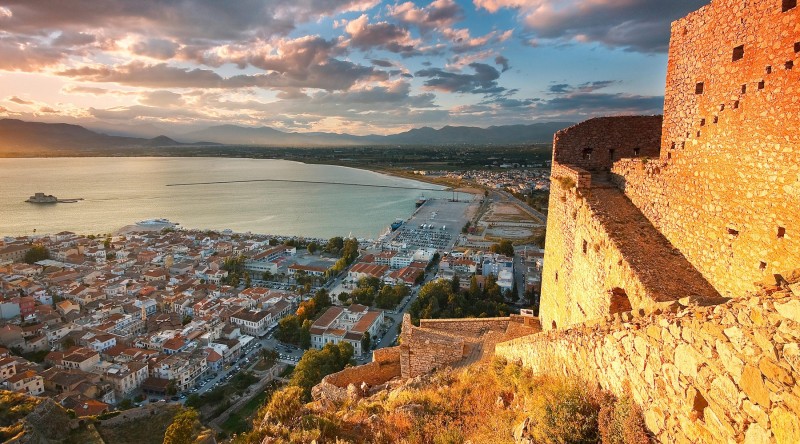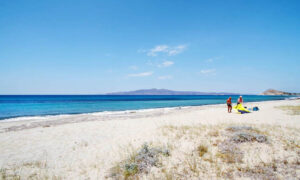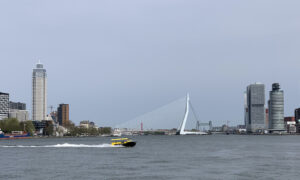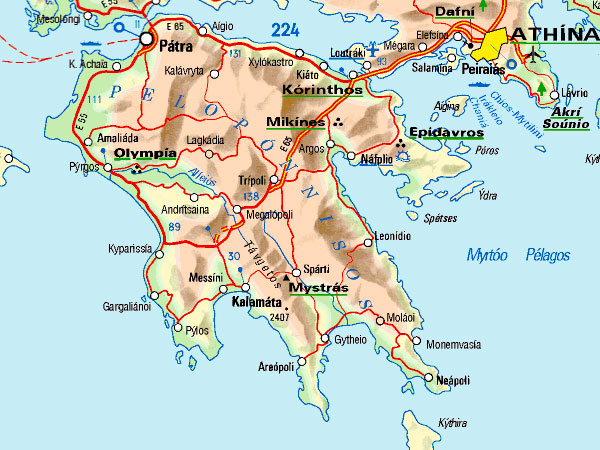
(Editor’s note: Lynne Evans recently relocated to a village outside Corinth from Athens. So this is literally her back yard.)
On the sea west of Athens in Peloponnese, Corinth is usually passed over on a tourist’s itinerary. To be honest, I can’t see any reason for this to change. The modern city, with a population of approximately 30,000 people is much the same as other Peloponnesian cities such as Sparti and Kalamata.
Of course, the statues are different in each city and each has something to recommend it, but on the whole the attractions are outside the cities, with the area packed with history and ancient ruins.
In fact, some of the most inviting of Greece’s ancient cities and ruins are an easy drive outside Corinth.
Ancient Corinth and Akrocorinth
Ancient Corinth, which is only a few kilometres from the modern city, is where Saint Paul spoke to the Corinthians, and if you visit the ruins you too can walk in the footsteps of Saint Paul.
It takes about an hour to walk around the ruined city and to visit the onsite museum. You can usually buy refreshments in the car parking area, but take your own, as you never know if there will be a strike, or if the facilities will be closed if you are not visiting in summer.
Most people don’t go up to the ancient citadel of Akrocorinth, which is a pity as it’s worth visiting if only for the view. You leave the car park and basically turn right and go up the hill. The signposting is not all it might be, so stop and ask the friendly locals. The road surface is pretty good until the final 50 metres, but persevere and you’ll find a welcoming taverna as well as the ancient city.
This site has architectural ruins which reflect the styles of the people who conquered the city as well as those of the ancient Greeks who founded it. You can see examples of Byzantine, Venetian and Ottoman architecture virtually side by side, or at least in layers.
Take a cardigan, wrap, or light jacket in summer as there’s usually a cold breeze at the top. In winter you need to be well wrapped up as the wind can feel icy.
Most visitors don’t manage to get to the very top of this ancient fortress, so don’t feel that you have to get right up there. The views are spectacular even from the car park at the base of the ancient city.
When you’re ready to go farther and stay in a hotel for a night, you could go on to Nafplio.
Nafplio
Nafplio (also spelled Nauplio and Nauplion) was the first capital of Greece after the 1821 War of Independence, which liberated Greece from Ottoman rule. It is a beautiful city with Neo-Classical buildings and names such as Syntagma Square (Constitution Square) with its old parliament building and palm trees. When Athens became the official new capital of Greece in1834, the parliament building (formally the royal palace), was located on the newly-named Syntagma Square,
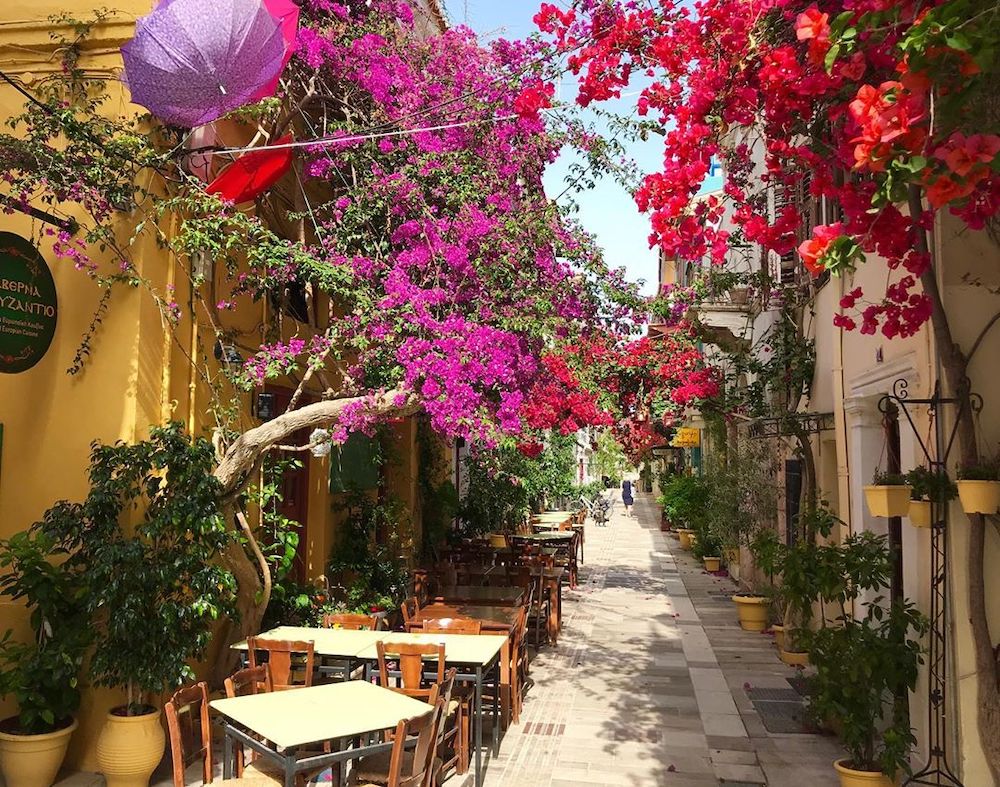
Walk around the square and take a side street so that you can explore the back streets where you will find ice-cream shops, cafés and small bars and tavernas. In summer the back streets are resplendent with vivid bougainvillea, which spreads from one side of the alleyway to the other, and the pungent aroma of jasmine.
You can take any side street and wander down to the sea where you will have views of the Bourtzoi fortress on the islet of Agioi Theodoroi (Saint Theodore), It may be possible to take a small boat to the island, but check both opening times and boat times. You might want to stroll along the promenade and stop for a drink or an ice-cream at one of the many café-bars.
Towering above Nafplio is the Palamidi fortress with its (alleged) 999 steps. These days you can drive up the hill to it, which is best during the summer months. Be advised the marble is slippery.
The highest rated hotels in Nafplio are:
Top-rated restaurants:
• Aeolus
Mycenae and Tiryns
It is worthwhile to stop at ancient Mycenae, site of Agamemnon’s palace stronghold. It’s a climb to reach the top but the views are worth it. There’s a museum at the site which has some very interesting artifacts taken from this site and the treasury, opposite the palace. There isn’t really anything to see at the treasury site, although you can visit it if you want to.
If you continue along the road towards Naufplio you will see the ruins of the ancient city of Tiryns, which is very closely connected to Hercules, a Greek hero.
You need to set aside half a day to explore these two sites, but don’t bother to eat in the town of Mykenes as it’s better to eat in Naufplio. (See above.)
Epidauros
If you are using Corinth as your base, don’t forget to visit Epidauros, site of the ancient theatre. If you visit during July and August, try to book seats for a play. You can book online on the Athens and Epidauros Festival site, but book early as seats sell quickly. You can, of course, simply visit the theatre without seeing a play,
In ancient times, people went to the sanctuary of Asklepios on the same site as the theatre, so you can visit this centre of healing too.
As you travel into the Peloponnese you may want to visit other ancient sites along your route, such as ancient Nemea, home to the infamous lion which Hercules reputedly killed. This region is now famous for its wine, another reason to go there.
The Peloponnese is beautiful and full of interesting places, each with its own cuisine, Stop and enjoy the delicacies.
About the author:

Lynne Evans is originally from Wales but is an inveterate traveller. She is passionate about writing and feels compelled to write something every day. Lynne has visited many countries in Europe and South Asia. Working as a freelance writer gives her opportunities to travel.
She’s currently living in her favourite country, Greece, in Athens. In the past, she was always leaving Greece and then returning. This time she wants to stay.
Here are more of Lynne’s posts about her adventures in Greece:
Expat Essentials: Lynne Evans’s expat guide to moving to Athens
Lynne Evans in Athens: An expat’s misadventures in the Greek healthcare system
Lynne Evans on daily life in Athens, the newly crowned European Capital of Innovation
Lynne Evans on Greece wildfires: ‘We can’t keep destroying Athens’ environment’
Lynne Evans in Athens: More tips to navigating the expat life in Greece
Lynne Evans: The trials, tribulations and absolute pleasures of living in Greece
Lynne Evans: The unvarnished truth about living in Greece


